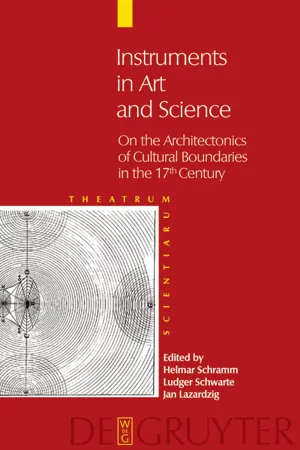
Instruments in Art and Science
On the Architectonics of Cultural Boundaries in the 17th Century
- 602 pages
- English
- PDF
- Available on iOS & Android
Instruments in Art and Science
On the Architectonics of Cultural Boundaries in the 17th Century
About This Book
Dieser Band versammelt originäre Beiträge am Schnittpunkt von Philosophie, Wissenschaftsgeschichte, Kultur- und Theaterwissenschaft. Auf der Grundlage von Falluntersuchungen zum 17. Jahrhundert trägt er zum Verständnis der Rolle bei, die Instrumente im Schnittfeld von Wissenschaft und Kunst spielen. Die Beiträge verfolgen dabei die Hypothese, dass die Entwicklung und Gestaltung von Instrumenten wesentlich zur Eröffnung neuer Felder des Wissens, zur Entstehung neuer kultureller Praktiken, aber auch zur Abgrenzung bestimmter Genres, Methoden und Disziplinen beiträgt. Diese Perspektive führt die Beiträge dieses Bandes dazu, auf neue Weise das, was ein Instrument überhaupt ausmacht, zu durchdenken und eine Reihe von Grundfragen zur Bestimmung des Instrumentes zu erarbeiten: Welche Handlungen verkörpert das Instrument? Welche Handlungen werden durch das Instrument ermöglicht? Wann werden Untersuchungsobjekte ihrerseits Instrumente? Welche Fähigkeiten setzt der Instrumentengebrauch voraus, welche produziert er?
Durch die Kombination neuer theoretischer Modelle und historischer Fallstudien, durch den detailgenauen Nachweis des gegenseitigen Einflusses von Kunst und Wissenschaft am Schnittpunkt des Instrumentes betritt dieser Band Neuland. Er ist von großem Wert für alle, die sich für die Vorgeschichte unsere instrumentengeleiteten Wahrnehmung interessieren.
Zu den Autoren des Bandes zählen neben den Herausgebern Jörg Jochen Berns, Olaf Breidbach, Georges Didi-Huberman, Peter Galison, Sybille Krämer, Dieter Mersch, Hans-Jörg Rheinberger, Wilhelm Schmidt-Biggemann und Otto Sibum.
Frequently asked questions
Information
Table of contents
- Editors’ Preface
- Contents
- Introduction: The Hand as “instrumentum instrumentorum”
- Intersections: Some Thoughts on Instruments and Objects in the Experimental Context of the Life Sciences
- Representation and Distortion: On the Construction of Rationality and Irrationality in Early Modern Modes of Representation
- World Orders and Corporal Worlds: Robert Fludd’s Tableau of Knowing and its Representation
- Telescope, Theater, and the Instrumental Revelation of New Worlds
- The Pathos of Function: Leonardo’s Technical Drawings
- “Il pennello artificioso”: On the Intelligence of the Brushstroke
- The Enlightenment “Catholization” of Projective Technology: Theurgy and the Media Origins of Art
- The Machine as Spectacle: Function and Admiration in Seventeenth-Century Perspectives on Machines
- The Anatomy of the Brain as Instrumentalization of Reason
- The “Chymistry Laboratory”: On the Function of the Experiment in Seventeenth-Century Scientific Discourse
- The Order of Knowledge, of Instruments, and of Leiden University, ca. 1700
- The Ideal Musaeum Kircherianum and the Ignatian Exercitia spiritualia
- Organology: The Study of Musical Instruments in the 17<sup>th</sup> Century
- In Sound Similar to the Harps: Early Descriptions of African Musical Instruments
- Machines, Bats, and Scholars: Experimental Knowledge in the Late Eighteenth and Nineteenth Centuries
- Scientific Coordination as Ethos and Epistemology
- Breaking, Grinding, Burning: Instrumental Aspects in Early Microscopical Pictures
- The Instrument in the Image: Revealing and Concealing the Condition of the Probing Tip in Scanning Tunneling Microscopic Image Design
- Formal Signs and Numerical Computation: Between Intuitionism and Formalism. Critique of Computational Reason
- Art Precedes Science: or Did the Camera Obscura Invent Modern Science?
- Instrumentalities of Place in Science and Art
- The Eye Opens, the Lamp Goes Out: Remarks on Bergson and Cinematography
- The Illusion of Power: Central Bank Money
- The Productivity of Blanks: On the Mathematical Zero and the Vanishing Point in Central Perspective. Remarks on the Convergences between Science and Art in the Early Modern Period
- Instrumental Sound and Ruling Spaces of Resonance in the Early Modern Period: On the Acoustic Setting of the Princely potestas Claims within a Ceremonial Frame
- About the Authors
- Image Credits
- Bibliography
- Index of Names
- Index of Subjects